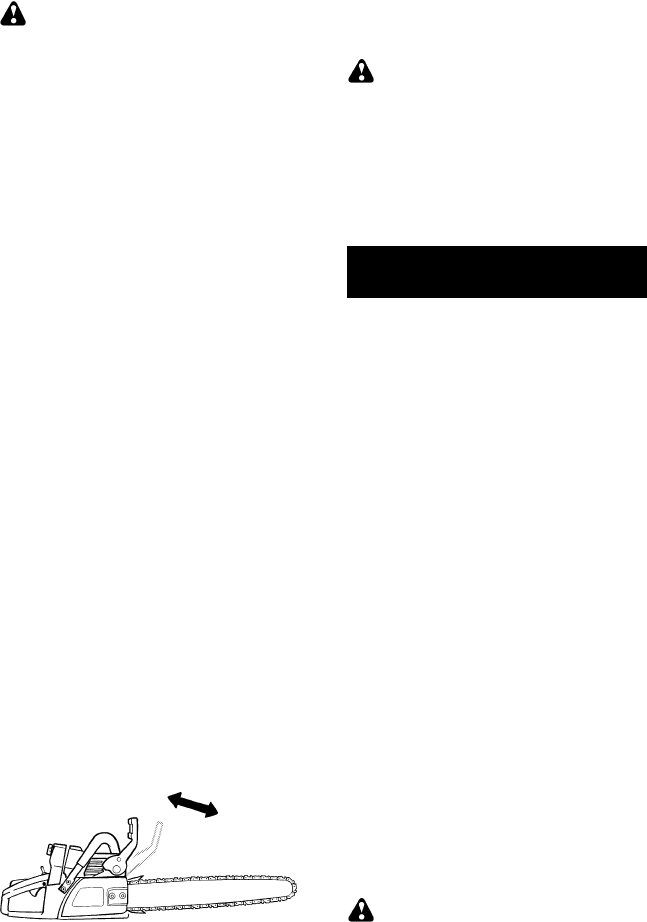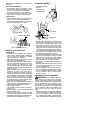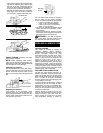
9
CHAIN BRAKE
WARNING:
WE DO NOT REP-
RESENT AND YOU SHOULD NOT AS-
SUME THAT THE CHAIN BRAKE WILL
PROTECT YOU IN THE EVENT OF A
KICKBACK. Kickback is a lightning fast ac-
tion which throws the bar and rotating chain
back and up toward the operator. Kickback
can be caused byallowing contact of the bar
tip in the danger zone with any hard object.
Kickback canalso becaused bypinching the
sawchain along thetop ofthe guide bar. This
action may push the guide bar rapidly back
toward the operator. Either of these events
may cause you to lose control of the saw
which could result in serious injury or even
death. DO NOT R ELY UPON ANY OFTHE
SAFETY DEVICES BUILT INTO YOUR
SAW. YOU SHOULD USE THE SAW
PROPERLY AND CAREFULLY TO AVOID
KICKBACK. Reduced--kickback guide bars
and low--kickback saw c hains reduce the
chance and magnitude of kickback and are
recommended. Your saw has a low kick-
back chain and bar as original equipment. If
the brake band is worn too thin it may break
when the chain brake is triggered. With a
broken brake band, the chain brake will not
stop thechain. Thechain brakeshould be r e-
placed byan authorized service dealer if any
part is worn to less than 1/32” thick. Repairs
on a chain brake should be made by an au-
thorized service dealer. Take your unit to the
place of purchase if purchased from a ser-
vicing deal er, or to the nearest authorized
master service dealer.
S
This saw is equipped with a chain brake.
The brake is designed to stop the chain if
kickback occurs.
S
The inertia--activated chain brake is
activated if the front hand guard is pushed
forward, either manually (by hand) or
automatically (by sudden movement).
S
If the brake is already activated, it is
disengaged by pulling the front handguard
back toward the front handle as far as
possible.
S
When cutting with the saw,the chain brake
must be disengaged.
Disengaged
Engaged
Braking function control
CAUTION:
The chain brake must be
checked several times daily. The engine
must berunning whenperforming this proce-
dure. This is the only instance when the saw
should be placed on the ground with the en-
gine running.
Place the saw on firm ground. Hold the han-
dles with both hands and apply full throttle.
Activate the chain brake by turning your left
wrist against the hand guard without releas-
ing your grip around the front handle. The
chain should stop immediately.
Inerti a activa ting functi o n contro l
WARNING:
When performing the
following procedure, the engine must be
turned off.
Hold the chain saw approximately 14” (35
cm)above astump orother wooden surface.
Release your grip on the front handle and
use the weight of the saw to let the top of the
guide bar fall forward and contact the stump.
When the tip of the bar hits the stump, the
brake should activate.
CUTTING METHODS
IMPORTANT POINTS
S
Check chain tension before first use and
after 1 minute of operation. See CHAIN
TENSION in the ASSEMBLY section.
S
Cut wood only . Do not cut metal, plastics,
masonry, non-wood building materials, etc.
S
Stop the saw if the chain strikes a foreign
object. Inspect the saw and repair parts as
necessary.
S
Keep the chain out of dirt and sand. Even a
small amount of dirt will quickly dull a chain
and increase the possibility of kickb ac k .
S
Practice cutting a few small logs us-
ing the following techniques to get
the “feel” of using your saw before
you begin a major sawing operation.
S
Squeeze the throttle trigger and al-
low the engine to reach full speed
before cutting.
S
Begin cutting with the saw frame
against the log.
S
Keep the engine at full speed the en-
tire time you are cutting.
S
Allow the chain to cut for you. Exert
only light downward pressure.
S
Release the throttle trigger as soon
as the cut is completed, allowing the
engine to idle. If you run the saw at
full throttle without a cutting load, un-
necessary wear can occur.
S
To avoid losing control when cut is
complete, do not put pressure on
saw at end of cut.
S
Stop the engine before setting the saw
down.
TREE FELLING TECHNIQUES
WARNING:
Check for broken or
dead branches which can fall while cutting
causing serious injury. Do notcut nearbuild-
ings or electrical wires if you do not know the
direction of tree fall, at night since youwill not
be able to see well, or during bad weather
such as rain, snow , or strong winds, etc.
S
Carefully planyour sawingoperation in ad-
vance.
S
Cleartheworkarea. Youneed acleararea
all around the tree so you can have secure
footing.

















